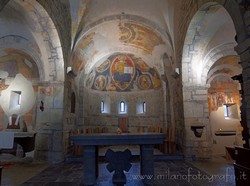|
Sotto il Monte (Bergamo, Italy): Abbey of Sant'Egidio
|
|
|
Show an other place around Milan worth a visit: |
 The history of the Abbey of Sant'Egidio, located on the eastern side of Mount Canto and whose full name is Abbey Rectory of Sant'Egidio in Fontanella, started in 1080. It was born as a Cluniac priory and it was created due to will of Alberto da Prezzate, important and rich person of the area converted to monasticism. The history of the Abbey of Sant'Egidio, located on the eastern side of Mount Canto and whose full name is Abbey Rectory of Sant'Egidio in Fontanella, started in 1080. It was born as a Cluniac priory and it was created due to will of Alberto da Prezzate, important and rich person of the area converted to monasticism.
The community referred to the Benedictine rule and entered into the European network of priories that developed starting from Cluny and around Cluny.
The April 12, 1473 Pope Sixtus IV took the monastic community from Fontanella. The October 8, 1575 the priory was annexed (along with the priory of Pontida) to the assets of the Basilica of San Marco in Venice by the archbishop of Milan, Carlo Borromeo.
For two and a half centuries since the end of the seventeenth century it was a parish church.
On 18 May 1998 the bishop of Bergamo Roberto Amadei made it bishop's chapel.
The church is a fine example of Bergamo Romanesque style. Its structure is that of a basilica. The interior has three naves separated by arches resting on stone columns with carved capitals all different from each other.
The roof is of wooden trusses in the aisles, while starting from the transept the roof is vaulted. Note that, in the backside, the roof is covered by thin stone plates.
As typical for the Romanesque, every aisle ends with a circular apse.
The church is rather dark, because the windows are few and small.
Another typical Romanesque element is the decoration of hanging arches under the roof.
As regards the outside, another characterizing element of the church is represented by the large bell tower with a square section and with a great conical cusp. It stands above the presbytery and it has therefore to be accessed via a staircase that passes over the roof.
The interior hosts various frescoes from various epochs. The older ones (centuries XI-XIII) are present in the form of fragments located mostly in the central presbytery (fig. 2). In particular, it is possible to recognize an angel holding aloft an imperial shield studded with a Easter lamb (on the barrel vault in front of the apse).
Of the Renaissance period (end of '400 - beginning of' 500) are instead the large fresco on the wall of the left aisle, shaped like an altarpiece, which includes depictions of various saints and the dead Christ mourned by the Virgin and another woman. Of the same period are the decoration inside the central apse, depicting a Christ Pantocrator surrounded by the four evangelists, the fresco of the Madonna with child enthroned on the right wall and the decoration of the lunette in the room in front of the left apse.
Baroque are finally the beautiful frescoes in the right apse (by Cristoforo I Baschenis, 1574, fig. 3), the small fresco of St. Anthony and St. Rocco near the baptismal font and the frescoes in the left presbitery.
On the wall right of the main entrance there is now a polyptych removed from a previous existing altar in the church. Painted on wood and of the Bergamo school, it is attributed to Giovanni Giacomo Gavasio from Poscante (XVI century).
The altarpiece, removed at the time of the last restoration in the years around 2000, was recently replaced with panels, supported by a metal structure, which reproduce the various parts.
The church is part of a complex itself very beautiful. Right of the church there is a beautiful courtyard with balconies with wooden balustrades connecting the different rooms. In the courtyard there is a small porch leaning against the right side of the church, in which a small sacellum is placed, with a burial called of Teoperga, the sister of the donor and founder of the Abbey.
Finally, it should be mentioned that Fontanella is a fraction of Sotto il Monte, birthplace of Pope John XXIII.
Categories: Places of historical value of artistic value
via Regina Teoperga, 16 - 24039 Sotto il Monte |
Further pictures of Abbey of Sant'Egidio in the section Photography |